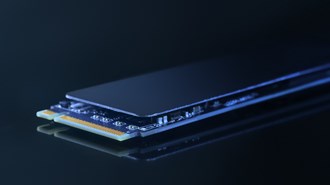Tech Talk
SATA vs NVMe: The Differences and Use Cases

Last updated 27 March 2024
SATA (Serial ATA) and NVMe (Non-Volatile Memory Express) are today still the both common types of SSD technologies. Outside of these two, SAS (Serial Attached SCSI) is a technology that still holds use and relevance in the market, but that's a conversation for another day. Today, we're focusing on SATA vs NVMe and the differences between the two.
On the surface, there are some clear differences with advantages for both - but without a doubt, SATA is a more legacy type of SSD with NVMe setting the standard of SSD for the future.
You'll commonly find SATA SSDs in earlier systems. These SSDs utelise legacy interfaces designed for the traditional hard drive. With this, performance potential is limited. For NVMe SSDs, they leverage a more streamlined and faster pathway for communication protocol, optimised for flash storage and able to transfer data at the highest speeds on the market, whilst reducing latency, making these a key type of SSDS for cloud and edge computing - moreover, future technologies like AI, machine learning, and IoT.
Use cases for SATA
SATA SSDs serve a range of computing needs where affordability, versatility, and satisfactory performance are paramount. They are commonly employed in:
Upgrading legacy/older systems
In older workstation devices where HDD may or is in use, SATA SSD can fit an upgrade path within that system where it may lack NVMe support. Compared to HDD, whilst a SATA SSD isn't at the performance level of an NVMe SSD, such drives can bring new performance to that system compared to that of a traditional drive.
Backup storage
SATA SSDs still bring a balance of performance and cost-effectiveness. Whilst the gap between NVMe and SATA cost isn't what it was, their lower cost per gigabyte makes them an economical choice for expanding storage capacity without compromise of reliability. Thus, they are well suited as a backup or secondary storage for long-term data retention and applications for backup.
Use cases for NVMe
Whilst the first flash-based SSD drives used SATA and SAS interfaces and protocols, these were designed to minimise change in existing HDD server and storage systems - not to push the boundaries further, through high speed storage within NAND. NVMe however as a protocol is built on high speed PCIe lanes, which can offer a transfer speed 2x than of SATA.
Enterprise Systems
Performance wise, data centre and enterprise need look no further than NVMe. Connecting directly to the server CPU through PCIe, and not through host bus adapters in legacy drive use, bottlenecks are reduced to keep data moving in and out of the CPUs, with NVMe delivering a big boost in bandwidth and IOPS. Also for future proofing, the introduction of NVMe-oF allows NVMe technology to extend beyond the current PCIe architecture.
HPC, AI, and ML
The superior read and write speeds can dramatically reduce processing times in the overall system. This makes NVMe SSDs ideal for use in HPC clusters and supercomputers, as such. When it comes to simulations and big data analytics, they're the only fit compared to SATA. The same for AI and Machine Learning, this type of SSD plays a crucial role in accelerating these highly intelligence applications to facilitate large datasets and AI-driven decision-making.
Key differences between the two
- Speed: NVMe which uses PCIe lanes run at 1GB per second. As an example, a standard NVMe SSD can be attached to four lanes thus supporting 4GB per second. With a SATA SSD, these run at 0.5GB per second. You can do the math here. The throughput is multiple times higher.
- Bandwidth: Again, coming back to the PCIe connection which the NVMe uses - it supports more bandwidth than a SATA port. The pure scalability of PCIe compared to SATA through the use of more lanes enables double the bandwidth.
- Compatibility: As mentioned in the use cases above, compatibility is a huge difference and key importance. The growth of AI and cloud favours NVMe. The technology works in tandem with modern OS, not just server - but consumer laptops, smartphones and gaming systems.
Form Factors
Commonly, SATA SSDs are 2.5" - but for NVMe drives, they're built for not just form factors of today, but emerging form factors to fit a variety of systems and devices:
| Form Factor | SATA | NVMe |
| M.2 | Yes | Yes |
| 2.5" | Yes | Yes |
| U.2 | No | Yes |
| U.3 | No | Yes |
| E1.S & L | No | Yes |
| E3.S & L | No | Yes |
The right SSD fit
Evidently, NVMe is protocol designed for flash SSD in mind for now and tomorrows world. The emergence of PCIe and the ability for SSDs for communicate directly with he CPU to reduce latency and create much better performance, means that improvements and the fit for emerging technologies like AI sit only with NVMe SSD.
With NVMe prices similar, if not cheaper in some instances right now that SATA, as a business you may find that it's a no brainer to give yourself the extra boost through a faster and more versatile SSD in NVMe.